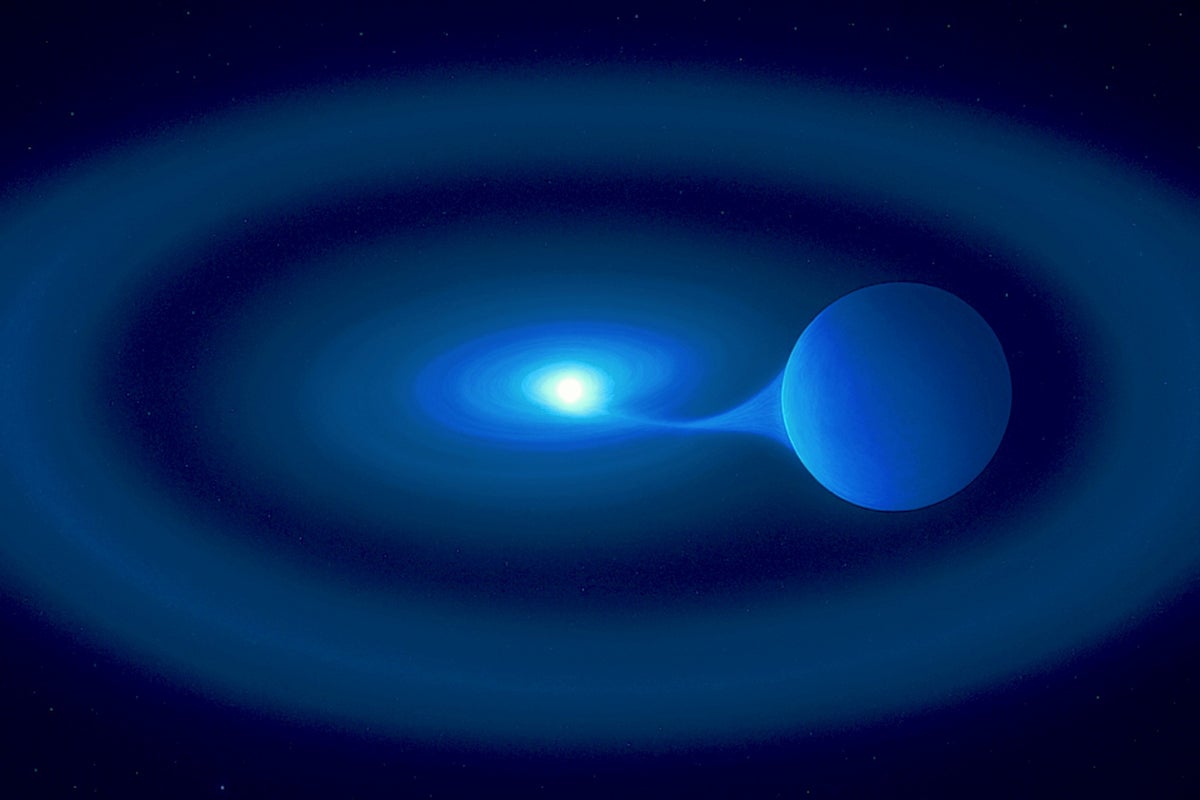Science
Astronomers Discover Greedy Star Devouring Twin in Space

A team of international astronomers has uncovered a rare phenomenon involving a white dwarf star known as V Sagittae, which is “going thermonuclear” as it consumes its larger twin at an unprecedented rate. This discovery reveals the star’s extraordinary brightness and the dynamic nature of its interaction with its companion, located approximately 10,000 light-years from Earth.
New Insights on Stellar Behavior
Researchers from the University of Southampton reported that V Sagittae is exhibiting a unique behavior, described as a “feeding frenzy,” where the super-dense white dwarf is aggressively pulling material from its neighboring star. This gravitational interaction leads to the white dwarf burning unusually bright, potentially culminating in a nova explosion visible from Earth.
The study indicates that V Sagittae is locked in a close orbit with its twin, completing a full rotation every 12.3 hours. As the stars draw closer together, the white dwarf is expected to create a massive explosion, which could be bright enough to be seen with the naked eye.
Professor Phil Charles from Hampshire University emphasized the uniqueness of this star system, stating, “V Sagittae is no ordinary star system – it’s the brightest of its kind and has baffled experts since it was first discovered in 1902.” He explained that the extreme brightness is due to the white dwarf’s consumption of its companion star, resulting in a process that is causing thermonuclear reactions on its surface.
Cosmic Ring and Imminent Explosion
The research, published in the Monthly Notices of the Royal Astronomical Society, also identified a ring of gas surrounding both stars, formed from the vast amounts of energy produced by the white dwarf’s feeding behavior. Lead researcher, Dr. Pasi Hakala from the University of Turku in Finland, noted that this cosmic halo is a byproduct of the white dwarf’s inability to consume all the mass being transferred from its twin.
Dr. Hakala further highlighted the chaotic movement of this stellar system, indicating that the extreme brightness is a sign of its impending, violent end. “The speed at which this doomed stellar system is lurching wildly is a frantic sign of its imminent, violent end,” he said.
According to Dr. Pablo Rodriguez-Gil from Spain’s Instituto de Astrofisica de Canarias, the accumulation of matter on the white dwarf is likely to result in a nova outburst in the coming years, during which V Sagittae will become visible even in daylight. The eventual collision and explosion of the two stars could produce a supernova bright enough to be seen from Earth, even during the day.
This discovery provides valuable insights into the complex interactions of binary star systems and the dynamic processes that lead to stellar explosions. As astronomers continue to study V Sagittae, they hope to unlock further mysteries surrounding these captivating celestial phenomena.
-

 Health2 months ago
Health2 months agoNeurologist Warns Excessive Use of Supplements Can Harm Brain
-

 Health3 months ago
Health3 months agoFiona Phillips’ Husband Shares Heartfelt Update on Her Alzheimer’s Journey
-

 Science4 weeks ago
Science4 weeks agoBrian Cox Addresses Claims of Alien Probe in 3I/ATLAS Discovery
-

 Science4 weeks ago
Science4 weeks agoNASA Investigates Unusual Comet 3I/ATLAS; New Findings Emerge
-

 Science3 weeks ago
Science3 weeks agoScientists Examine 3I/ATLAS: Alien Artifact or Cosmic Oddity?
-

 Science3 weeks ago
Science3 weeks agoNASA Investigates Speedy Object 3I/ATLAS, Sparking Speculation
-

 Entertainment4 months ago
Entertainment4 months agoKerry Katona Discusses Future Baby Plans and Brian McFadden’s Wedding
-

 World2 months ago
World2 months agoCole Palmer’s Cryptic Message to Kobbie Mainoo Following Loan Talks
-

 Entertainment4 months ago
Entertainment4 months agoEmmerdale Faces Tension as Dylan and April’s Lives Hang in the Balance
-

 Science3 weeks ago
Science3 weeks agoNASA Scientists Explore Origins of 3I/ATLAS, a Fast-Moving Visitor
-

 Entertainment4 months ago
Entertainment4 months agoLove Island Star Toni Laite’s Mother Expresses Disappointment Over Coupling Decision
-

 Entertainment3 months ago
Entertainment3 months agoMajor Cast Changes at Coronation Street: Exits and Returns in 2025









